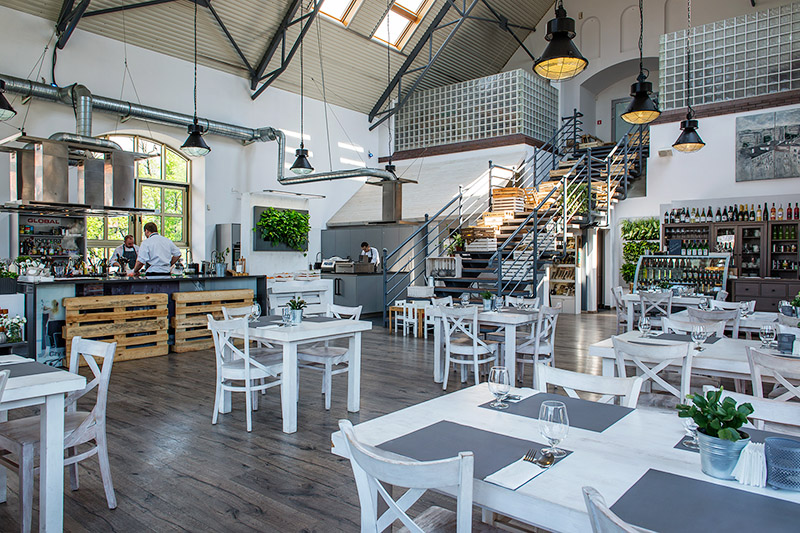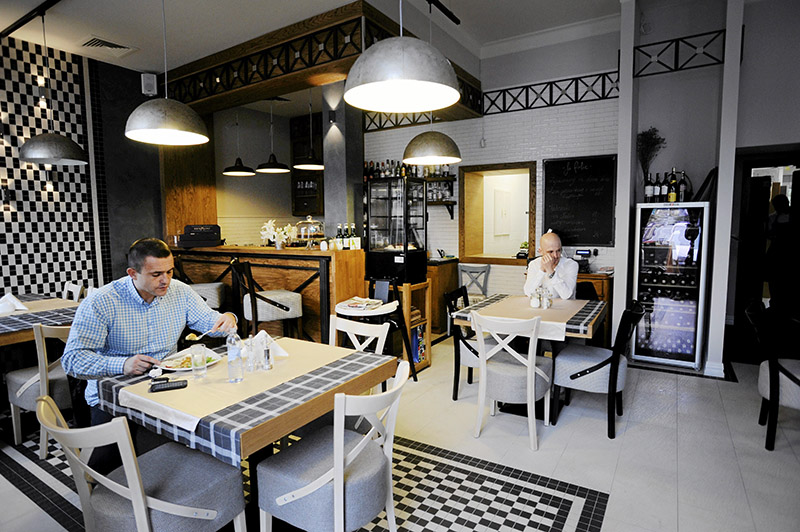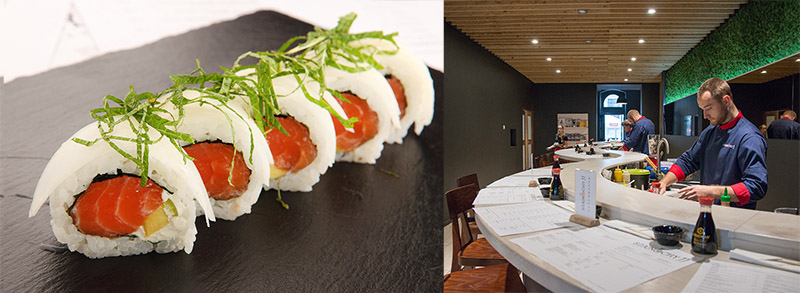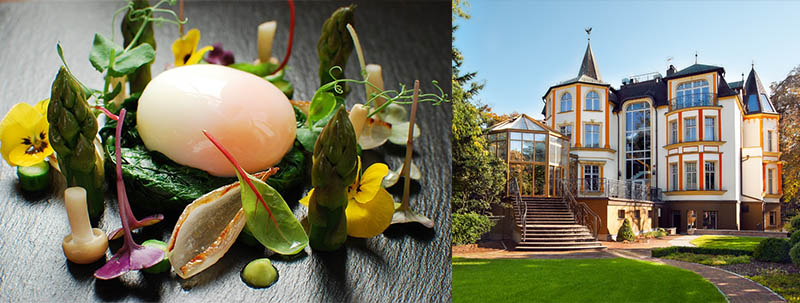Acquario
 Acquario Restaurant, photo: press materials
Acquario Restaurant, photo: press materialsAcquario is on the top floor of the neo-Baroque hotel Monopol. Its modern and glassed-in interior provides a view of the Old Town, and also, thanks to its open kitchen, you can watch the chefs at work. It has a spacious terrace as well, a great place to have a meal, especially during the summer. The head chef at Acquario is Justyna Słupska-Kartaczowska, who has received the title of Best Female Chef of 2016. Before she became a professional cook she spent many years in France. In Paris she studied art history as well as film and theatre make-up. She gained culinary experience at renowned restaurants, such as La Palme d' Or 2 at the Martinez Hotel in Cannes. Acquario serves a tasting menu each evening. The herb dumpling with liquid parmesan and cabbage cream is a real treat, as is the zander with 3 kinds of cucumber – fresh, lightly pickled and pickled. The corned beef tenderloin is served with freshly grated horseradish and a side of marinated onions, beetroot mousse and fat from a pig of the Złotnicka breed. The chef’s ‘fetishes’ are foie gras, truffles, and fresh coriander, so she often uses these ingredients in her cooking. Foie gras on polenta with strawberries – enough said.
Monopol
 Monopol Restaurant, photo: press materials
Monopol Restaurant, photo: press materialsThe Monopol restaurant is located in the hotel of the same name mentioned above. It’s worth noting that this luxurious hotel built toward the end of the 19th century enjoyed great prominence in the Interwar period, when it hosted exquisite balls and was frequented by bohemian artists like Jan Kiepura, Karol Szymanowski, and Artur Rubinstein. As in the case of Acquario, the kitchen in Monopol is run by Justyna Słupska-Kartaczowska. The main theme here is Polish cuisine, approached innovatively and originally arranged, but simple and focusing on highlighting the natural taste of products. On one hand it references old recipes, on the other it gives them a modern twist. So if you order jellied pork as an appetiser, it’ll be served with elderberry vinegar, should you choose pierogi (dumplings) for an entrée, you’ll get them with smoked quark, mint, and millet. The main courses are splendidly appetizing, e.g., the ale-glazed knuckle of pork with dill and dumplings. What are the dessert options? Cheesecake or Lower Silesia’s finest farmhouse cheeses served with currant mustard are just some of the restaurant's offerings.
Food Art Gallery
 Food Art Gallery Restaurant, photo: Maciej Świerczyńsk / AG. Selection of cheeses, photo: press materials
Food Art Gallery Restaurant, photo: Maciej Świerczyńsk / AG. Selection of cheeses, photo: press materialsAs the name would suggest, gastronomy meets art in this place opened in 2014 – it’s an elegant restaurant combined with a modern art gallery. Here you can not only enjoy a tasty meal but also contemplate the paintings displayed on the walls. The chef at Food Art Gallery is Rafał Tytuła, who sharpened his skills under the tutelage of such world class chefs as Pascal Aussignac and has a dozen or so years of experience working at London restaurants. Tytuła believes that ‘fresh and natural ingredients make the character of a dish and skilfully combining them results in flavours you want to return to’. At this restaurant, where Polish tastes gain a new dimension, the cooking is creative and modern. The surf and turf style is an important source of inspiration for the menu which is why it includes seafood like lobsters and scallops alongside dishes such as rump of lamb with rosemary purée, green beans, and a side of sweetbread.
Studio Culinary Solutions & Slow Food Bistro
 Studio Culinary Solutions & Slow Food Bistro, photo: Witold Gidel
Studio Culinary Solutions & Slow Food Bistro, photo: Witold GidelThis restaurant operates in a former palace estate in the village of Bielany Wrocławskie, just outside Wrocław. Łukasz Terlikowski, who started his career as a professional chef 20 years ago, is responsible for the food here. He has worked at restaurants not only in Wrocław but also in Great Britain (e.g. Palm Court in Brighton). At Studio Culinary Solutions & Slow Food Bistro he practices the principles of slow food but also maintains the culinary tradition of Lower Silesia without being overly conservative – he merges history with modernity and local flavours with international ones. Sitting near plants and paintings by local artists you can try dishes based on seasonal products, for example, duck with beans and white sausage, although occasionally selected international products also make their way to the table.
Olszewskiego 128
 Olszewskiego 128 Restaurant, photo. press materials
Olszewskiego 128 Restaurant, photo. press materialsThis place is far away from the city’s culinary centre, in the Biskupin neighbourhood. The décor is simple and appealing, light pastel colours are predominant. The kitchen is run by Katarzyna Daniłowicz, winner of the 4th edition of the culinary show Top Chef. An architect by education, she has been fascinated with cooking for years. Her dream of opening a restaurant came true thanks to the joint efforts of her and an old friend of hers. The guests at Olszewskiego 128 are offered dishes made from seasonal and local products, inspired by classic cuisine, but including surprising combinations – various flavours and cooking styles come together here. The kitchen makes use of, amongst others, local goat cheese, rapeseed oil, flour from local mills, and fish from the Milickie ponds. When it's in season, you can order the delicious smoked eel with marinated radish dumplings and young potatoes or the scrumptious chłodnik (cold soup) based on sorrel and buttermilk. For dessert you can have mini doughnuts in rosewater with cherry ptasie mleczko (‘bird's milk’, meringue or soufflé in chocolate) rose jam, poppy seed, and ice cream made from young spruce shoots, for example.
La Folie
 Interior of La Folie, photo: Kornelia Głowacka-Wolf / AG
Interior of La Folie, photo: Kornelia Głowacka-Wolf / AGLa Folie is situated in the centre of Wrocław’s tourist area, in Solny Square. The place is small but cosy – it brings to mind a French bistro. The head chef, Dawid Ankowski, enriches the classic tradition with new techniques, concoctions, and methods of presentation by composing a short, seasonal menu based partially on Polish products but also inspired by French cuisine. The house speciality is beef: American, Argentinian, Polish, and Japanese Kobe. The menu also includes plenty of seafood and freshwater fish. The chopped beef steak tartare is served with capers, marinated chanterelles, onion, olive oil, green tomato and a sous vide yolk. Or maybe you should go with the duck breast with broad beans, chanterelles, gooseberries, cherries and nasturtium leaves?
Szajnochy 11
 Tropic - dish form Szajnochy 11 Restaurant, photo: curtesy of the Szajnochy 11
Tropic - dish form Szajnochy 11 Restaurant, photo: curtesy of the Szajnochy 11On one hand Szajnochy 11 is an establishment that serves sushi as well as other dishes made from fish, seafood and local vegetables. On the other, it is the signature space of Tomasz Hartman, a chef known for his involvement with Food Think Tank, a group of specialists collaborating on interdisciplinary projects which we wrote about last year here . This restaurant's seasonal menus each feature a particular culinary technique of old, such as pickling, smoking, or drying, as their main theme. On Szajnochy 11’s website you can read a message from the people behind the place:
We think about how to polish our skills and learn more every day. We have been serving traditional and elaborate sushi for a few years… We focus on fish and seafood of the highest quality, for which we regularly travel to Dutch and German fish markets.
Grape Restaurant
 Grape Restaurant, view of the bulding and the Egg 64 c dish, photo: press materials / www.graperestaurant.pl
Grape Restaurant, view of the bulding and the Egg 64 c dish, photo: press materials / www.graperestaurant.plThis establishment is situated in a renovated pre-war villa neighbouring Centennial Hall, Szczytnicki Park, and the Japanese Garden. Its head chef, Łukasz Dudziński, has a lot of culinary experience, for example, at the Savoy Hotel's restaurant in London. At Grape Restaurant he uses products typical of Polish cuisine, but not only. That’s why here you can order not only piglet, duck, rabbit, catfish, or herring, but also scallops and tuna. Some of the herbs used in the kitchen come from the restaurant’s garden. The herring is served with chanterelles and mountain cranberries, the duck with young carrots and pine honey.
Dinette
 Interior of Dinette inWrocław, photo: Kornelia Głowacka-Wolf / AG
Interior of Dinette inWrocław, photo: Kornelia Głowacka-Wolf / AGDinette is a place with an elegantly simple interior, located in the Sky Tower skyscraper. The short and frequently changed menu at Dinette is based on fresh and easily accessible products. It merges simplicity with refinement and offers original combinations of flavours. The head chef here is Paweł Bieganowski, who gathered culinary experience in Great Britain and the Netherlands, working for instance at such Amsterdam hotels as Sofitel, the Grand, and Fashion.
Czarymary
 Czarymary Restaurant, photo: courtesy of the restaurant
Czarymary Restaurant, photo: courtesy of the restaurantThe last restaurant on this list is Czarymary, which you can find in the hotel and service complex Ibis Styles. Its head chef, Marcin Węglowski, has a background working at top London restaurants (e.g. Le Gavroche), and uses modern techniques and traditional products. On the international menu you’ll find seafood but also dishes associated with traditional cuisine, like slow cooked pork belly with carrots and mustard sauce or rabbit ballotine with chanterelles and whey sauce. The restaurant’s guests will most certainly notice its outstanding modern interior.